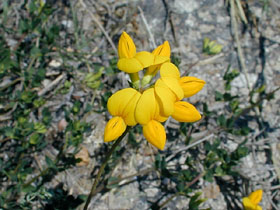BIRDS-FOOT TREFOIL
|
 |
| File Size: 70 KB |
|
|
|
Lotus corniculatus L.
|
| Riley County, Kansas |
| Perennial |
| Height: 3 - 24 inches |
| Family: Fabaceae - Bean Family |
| Flowering Period: May, June, July, August, September |
|
| Stems: | | Decumbent or rarely erect, several-branched from base. | | Leaves: | | Alternate, short-stalked, pinnately 5-foliolate; leaflets obovate to broadly lanceolate, 1/4 to 3/4 inch long, about 1/4 inch wide, nearly sessile, glabrous or slightly pubescent; tips blunt or pointed; 3 leaflets grouped together at tip of rachis, lower 2 at base of rachis and resembling stipules. | | Inflorescences: | | Umbels, 3-8-flowered, on stalks 4-6 inches long. | | Flowers: | | Showy; calyces 5-lobed; tips pointed; corollas papilionaceous, bright yellow to orange-red, about 1/2 inch long; stamens 10, 9 united, 1 free. | | Fruits: | | Pods, slender, linear, 1-1.5 inch long, dark brown to black, twisting somewhat when dry, resembling bird's feet; seeds 8-18, small, often spotted. | | Habitat: | | Roadsides, disturbed areas, fields, and waste ground. | | Distribution: | | East half of Kansas. | | Origin: | | This native of Europe was introduced into the U.S. and has escaped from planted areas. | | Forage Value: | | Drought resistant and produces nutritious, palatable forage for livestock and deer. It is thought not to cause bloat, as many legumes do. | | Uses: | | Game birds and small mammals eat the seeds. Bird's-foot trefoil is sometimes planted for pasture and hay, and for soil conservation along highways. | | Comments: | | The common name comes from the slender, spreading seed pods that resemble toes on a bird's foot. |
|
| Birds-foot trefoil |  | | 153 KB | | Riley County, Kansas |
| | Birds-foot trefoil flowers |  | | 66 KB | | Riley County, Kansas |
| | Birds-foot trefoil inflorescence |  | | 70 KB | | Riley County, Kansas |
| | Birds-foot trefoil pod |  | | 70 KB | | Riley County, Kansas |
| |
|
|
|
|
|
|






